‘Pickleball Is the Wild, Wild West’: Inside the Fight Over the Fastest-Growing Sport in America

This story was originally published on May 24, 2022. It was included in a year-end list of SI’s best stories of 2022.
In February 2021 an unholy tremor shook the seemingly carefree sport of pickleball: news that a second hall of fame was in the planning stages. The announcement, from USA Pickleball (heretofore USAP), incited a bevy of questions, such as: Wait, there’s a pickleball hall of fame? (Believe it or not.) Is anyone famous solely for playing pickleball? (Not yet.) Why stop at two? (Actually …)
Dinkheads.com, one of a plethora of pickleball blogs, referred to USAP’s intent to erect a rival Hall as a “douche-y” move, but it’s far more serious than that. The Hall is just one parry in a series of turf wars and satellite skirmishes plaguing the fastest growing sport in America—a sport whose ambitions extend from occupying real estate at your nearest park to reaching the Olympics. To wit:
- There exist two international—feuding—governing bodies: the relatively venerable International Federation of Pickleball (IFP) and the renegade World Pickleball Federation (WPF).
- And two domestic professional tours: the Association of Pickleball Professionals (APP) and its mirror-acronym rival, the Professional Pickleball Association (PPA).
- Meanwhile, a pair of competing Texas-based billionaires seem poised to go to the mattresses over the sport.
- All of this against a backdrop of well-founded angst among the tennis set that pickleball is usurping both its real estate and its participants.
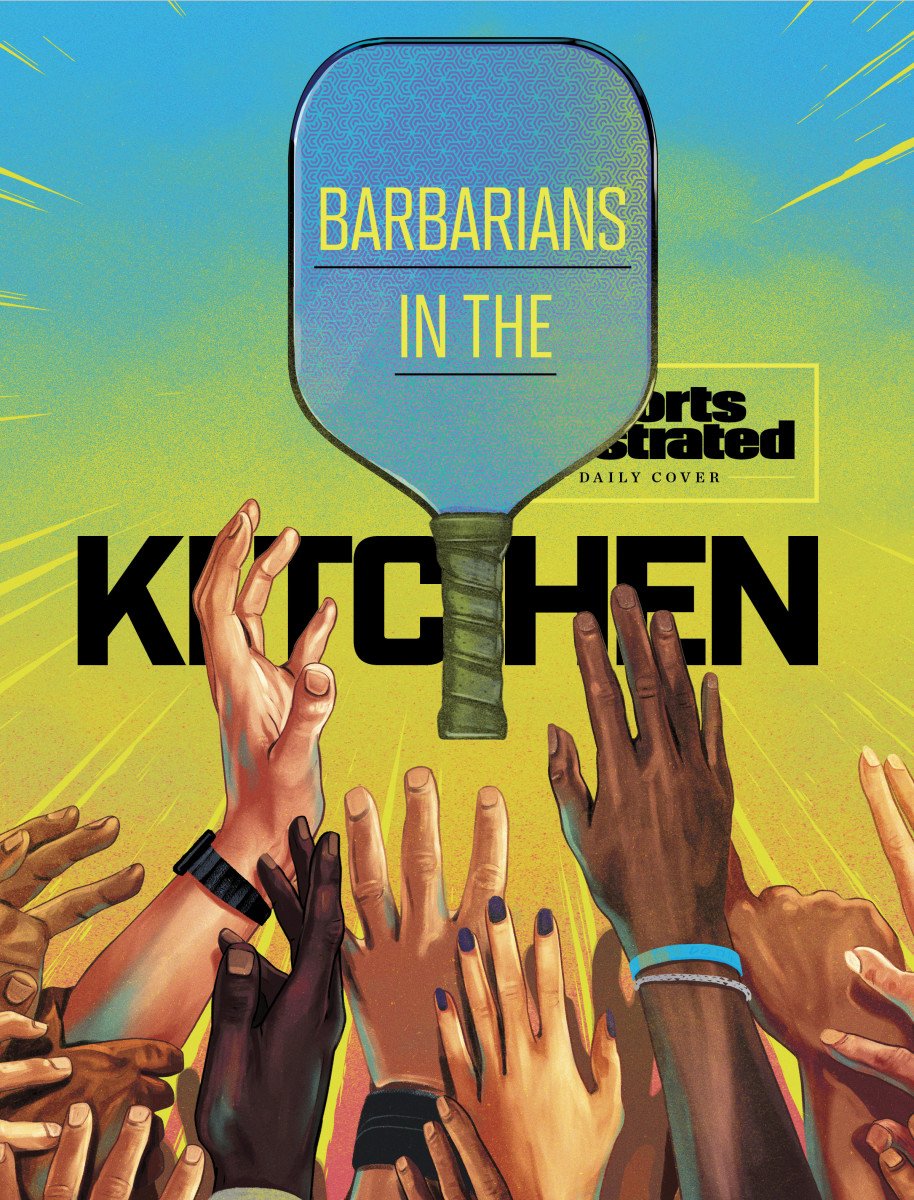
Until recently, pickleball was widely perceived as the last athletic refuge of those who had undergone a knee, hip or spouse replacement. In reality, the sport—where 300 different paddle manufacturers bear witness to an as-yet unrealized potential—is in the throes of its terrible tweens. Growing pains aplenty, and a litany of f-words: factions, fractures, friction … . In short, picklebalkanization.
“Some days you wake up,” says Connor Pardoe, founder of the PPA Tour, “and it all feels like a land grab.”
COUP DE PAT
On Feb. 14, 2022, something less than a Valentine’s e-card arrived in Pat Murphy’s inbox. For the president of the IFP—thus, the most powerful figure in the world of amateur pickleball—the missive was loaded with arrows. But not Cupid’s.
“As Board members and Directors of the International Federation of Pickleball,” the letter began, “we respectfully submit this letter of ’no confidence.’” It then cited 13 alleged breaches of protocol and called for the recipient’s “immediate resignation.”
Murphy, a genial but imperious gent in his late 60s, did not respond. Six weeks later, the letter’s 10 co-signees, representing two of the IFP’s five board members and all eight of its program directors, resigned en masse. Joining them: Nine of the 10 largest national governing bodies withdrew, including USAP, which governs nine of every 10 picklers on the planet. The lone holdout? India, whose commissioner, Sunil Valavalkar, is one of two board members who remain loyal to Murphy.
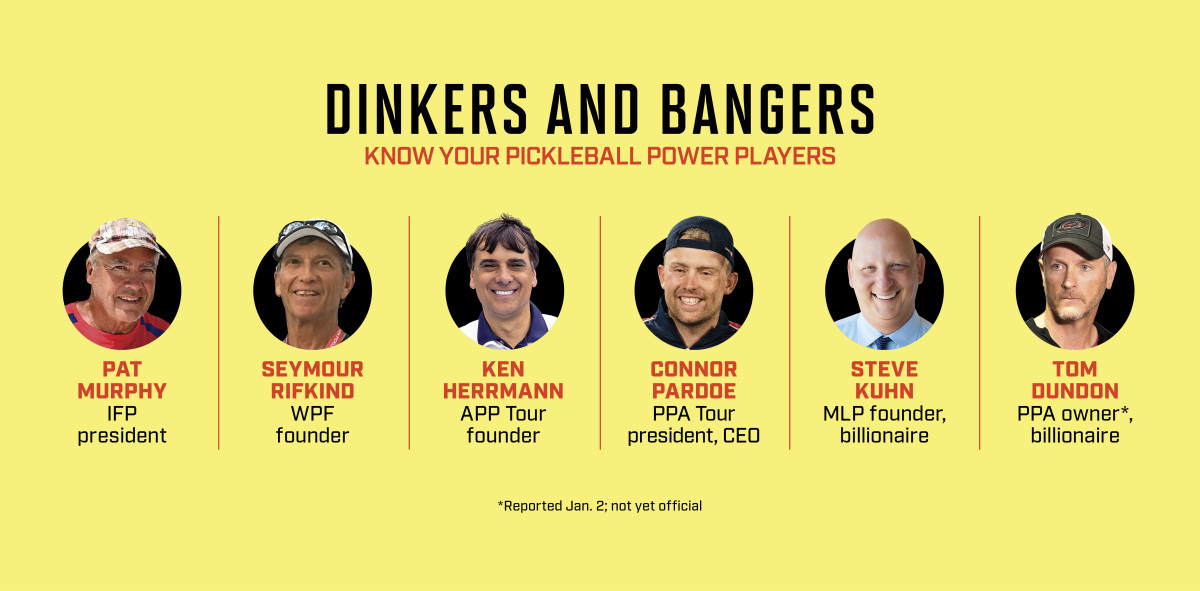
“That was the cannonball that went over the bow,” says Murphy, who remains the titular head at pickleball’s equivalent of FIFA (whereas USAP is like the U.S. Soccer Federation). He’s the captain of a ghost ship. As one resigned board member says with no small degree of resignation: “The IFP just lost 95% of the world’s registered players.”
For more than a decade the IFP has been the flagship of a grassroots (read: volunteer) movement to make pickleball an Olympic sport—at the earliest, likely 2032 in Brisbane. Suddenly, that ship has no crew or sails. Despite the coup de Pat, Murphy refuses to abandon his post.
PICKLE-BUZZ
Pickleball: the progeny of tennis and Ping-Pong. The new shuffleboard. “Half-court basketball for elderly people,” as actor Jeff Daniels put it.
Or so you thought.
You might have read about the sport with a silly name and 4.8 million adherents. Or seen your local park or tennis club—or Leo DiCaprio—install a pickleball court, or a dozen. Or heard that college hoops coaches Scott Drew (of Baylor) and Mark Few (Gonzaga), played each other in the Final Four bubble last year. Or caught Drew Brees’s recent tweet about his football afterlife: “I may train for the pickleball tour.”
“Pickleball is the social media influencer of the sports world,” Kelly Ripa said on Live With Kelly and Ryan. “I’d never heard about it. And then I only hear about it.”
Born in 1965 on Bainbridge Island, Wash., and mostly confined to the Pacific Northwest for half a century, pickleball got its name from “pickle boat” (a hastily assembled rowing crew), a nod to the paddle sport being cobbled together from parts of others: badminton, tennis, even Wiffle Ball. The moniker invited curiosity and derision in equal measures. But, as time passed and pickleball gained traction in sun-splashed, gated retirement communities from Palm Beach to Palm Desert, it became more addictive than Blue Bloods.
Now, pickle-buzz is inescapable, its proselytizers as zealous as crypto crusaders. One big reason: the gentlest of learning curves. “It’s so damn easy,” says 70-year-old Seymour Rifkind, founder of the IFP’s rival, the WPF, and, like so many figures in this story, a postretirement adoptee of the sport. “The first four or five years, I couldn’t wait until the next morning so I could go out and play again.”
“Of the hundreds of players I’ve taught to play,” says 73-year-old Steve Sidwell, a former IFP program director who signed his name to February’s no-confidence letter, “I have never heard This is no fun.”
“My in-laws, very active, play tennis three times a week,” says Chris Hall, a 51-year-old club pickleball pro in the Phoenix burbs. “But with pickleball, they play six times a week, sometimes twice a day.” Active adult living, indeed.
Eventually, obsession begat oversight, which begat structure. The money followed. And now, the turf wars.
“When I was running [USAP], we were trying to grow the sport,” says Mark “Yoda” Friedenberg, the original president of pickleball’s seminal governing body. “Now they’re primarily concerned with money.”
Pro tours. Sponsorships. Equipment. Instructor certification fees. Pickleball-themed franchises, akin to TopGolf. Streaming. TV. Much like crypto, the revenues are either ephemeral or invisible at the moment, but at least two billionaires have invested heavily. The sharks have arrived.
“Power and money,” says Lynn Cherry, who last year launched Pickleball Fire, a website and podcast. “It’s unfortunate, but I cannot say it’s unexpected.”
FRONTIER DAYS
“Pickleball’s the wild, Wild West,” says Justin Maloof, the COO of USAP. You hear that refrain plenty around this sport, but Maloof and I are seated in the midst of what once was the actual wild, Wild West.
On this weekend in April, the 41 pickleball courts at the Legacy Sports Park in Mesa, Ariz., are home to an APP Tour event, the Legacy Open. But 100 years ago we’d have been surrounded by nothing but saguaro cacti. Today, this mega sports complex is surrounded by tract homes and the grace notes of affluent exurbia: a Pita Jungle and a Trader Joe’s. They paved paradise, all right.
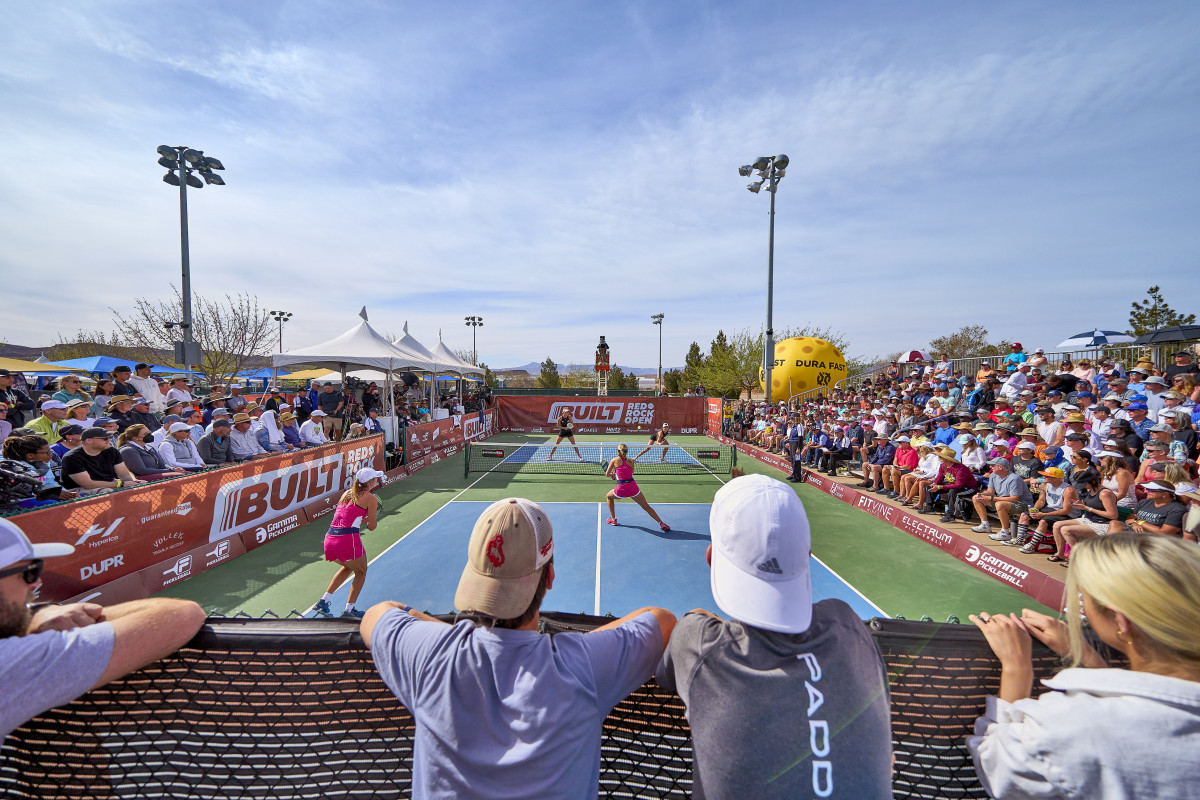
For better or worse is a matter of perspective. The same holds for pickleball. “This period of the past three or four years has kind of been a black eye,” says Maloof. “Look at any pro sport: two equal pro tours are not sustainable. We don’t need two international governing bodies.”
Maloof, like pickleball, was born and raised in the Pacific Northwest. He recalls playing the game as a boy in the ’80s, whereas his father now plays four times a week in his 70s. “We had pickleball in the schools,” says Maloof. “A family friend had a court in the backyard.”
For decades that was pickleball’s realm: primarily in backyards, primarily in Washington. The first nonwooden paddles were designed by a Boeing engineer. Then, in 2005, USAP was formed with the purpose of establishing a rule book, a tournament structure and a national membership program. From anarchy to order.
As president, Friedenberg installed a board of 14 members. “We were a governing body,” says the George Washington of pickleball. “If it’s only me, then we’re a company. I chose people who were deeply involved in pickleball.”
In 2009, the first national championships—at a 55-and-over community nearly 50 miles northwest of Phoenix—drew 400 players and offered $7,000 in prizes. The event was emblematic of pickleball’s place in the national consciousness: off the map.
One year later, USAP created the International Federation of Pickleball, rationalizing that “if the sport is gonna go global,” says Maloof, “it can’t be under the auspices of USAP.”
By global, Maloof means Olympics. To even be considered an Olympic sport pickleball would need a minimum of 75 USAP-type national governing bodies across the hemispheres. All of them, USAP included, would operate under the umbrella of the IFP … which USAP had spawned.
But first, pickleball had to blossom stateside. That was Maloof’s mandate. In 2015, the nationals were relocated to an RV park in Casa Grande, Ariz. And if that sounds like a scene from a Coen brothers film—well, yeah. Total prize money: still only $10,000.
By 2018, however, the pickleball invasion was in full swing. USAP signed a five-year deal with the famed Tennis Garden at Indian Wells and has hosted its prestigious tournament there ever since. The pandemic acted as an adrenaline boost for the sport, which organically conforms to both social fitness and social distancing. The total purse at this year’s nationals is expected to reach six figures.
“Everything is moving at lightning speed,” says Maloof.
Lightning creates thunder. Explosions that reverberate across the landscape. As pickleball mania surged with double-digit percentage increases in participation year over year, evangelists and opportunists appeared out of thin air. Collisions were inevitable.
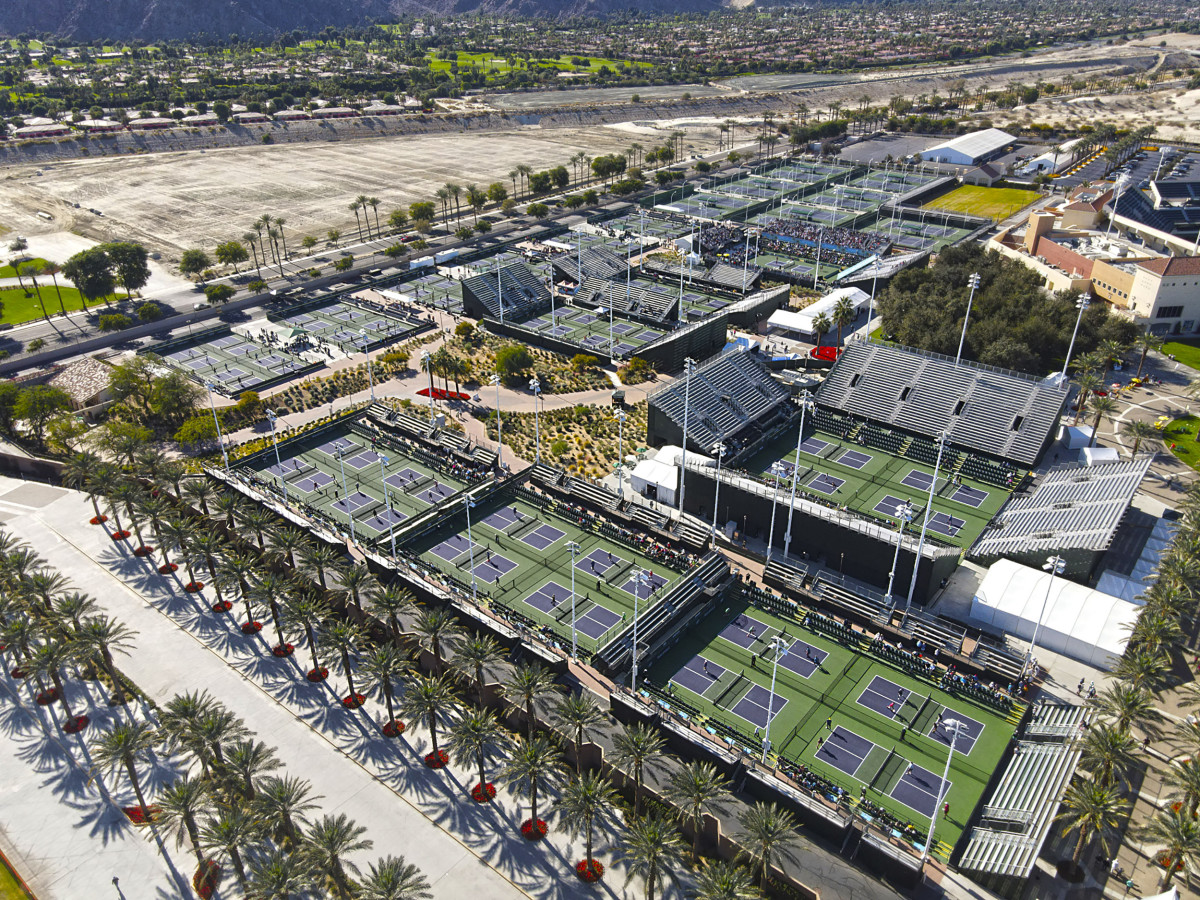
DINKERS AND BANGERS
In pickleball, play begins with an underhand serve. Baseline rallies are almost unheard of, particularly in doubles, where on most points all four players have advanced to the edge of the kitchen by the third or fourth hit.
What is the kitchen? A rectangular box extending seven feet from the net—a full court is 44’x20’—that players must remain outside while returning a volley. They may, however, venture inside to return a shot if the ball bounces inside the kitchen. (Doubles, by the way, is far more popular among players and spectators than singles, and mixed doubles may be the closest thing in sport to mansplaining, as the male typically returns at least 75% of the shots.)
By the fourth hit, a point is distilled into dinkers and bangers. To dink is to gently and repeatedly lob the perforated ball over the net, almost lulling your opponent—and spectators—to sleep. Dinks are why a single point can last upward of 50 shots. Eventually, though, someone opts to bang, to whack the ball from fewer than five yards away, setting off an exchange of rapid-fire shots. A slap fight with paddles.
Seymour Rifkind is a banger. “Some people think I’m a disruptor,” says the single-most disruptive force in pickleball.
Upon first encounter, “Rif” may incite an eye-roll or two. A self-made millionaire through his advertising firm, he has completed an Ironman. Earned a black belt in taekwondo. Run the famously unforgiving Badwater Ultramarathon. Bicycled solo from coast to coast. And all of this after his 50th birthday.
But Rif is a pickleball visionary. He created the game’s first certified instructor course and introduced its first system for rating players, similar to how tennis and table tennis operate at amateur levels. In 2017, he announced he was creating the first pickleball hall of fame. And in ’18 the World Pickleball Federation, a rival surrogate of the IFP.
“Seymour Rifkind is a doer,” says Karen Mitchell, the president of Pickleball England. “The WPF being around acted as a catalyst for the IFP to finally get things done.”
Rif says he first pitched all of his ideas—save for the WPF—to both USAP and the IFP, which at the time were overseen by essentially the same individuals. And “they were not at all interested,” Rif says. “I think there were big egos. In their view, they owned pickleball. If they didn’t come up with the idea, they’re going to copy it, or try to buy it from you.”
If you can’t join ‘em, beat ‘em. Rif’s WPF began vigilantly recruiting member nations. And you don’t need to be a game-theory expert to calculate that, as a foreign federation, the shrewd move was to register with both. Nearly two dozen countries—the notable exception being USAP—did just that.
Seymour Rifkind just cannot stay out of the kitchen. And he considers the folks at USAP and the IFP to be clueless dinkers. “I don’t think any of them had a vision for where the sport could go,” Rif says. “If they aren’t interested in doing it, then I have the skill set.”
THERE’S AN APP FOR THAT
Connor Pardoe moves at a frenetic pace, as befits a 27-year-old with two sets of twins under age 3. The University of Utah grad crackles with energy and ambition. Buff, blond and blue-eyed, he looks as much the No. 1 player in the world as any actual pro on either tour.
Pardoe is a banger. Hell yeah. In 2018, he and his father, Derk, a former tennis player at BYU, attended a pickleball tournament in Atlanta. “I said to my dad, ‘This is more fun than Indian Wells [the ATP event],” Pardoe says. “‘I think we can do this better.’”

At about the same time, Ken Herrmann was making plans to open a tennis club in suburban Chicago. On a whim, the former USTA coaching staff member took his blueprint to Wilson Sporting Goods in search of a partnership. “Where are all your pickleball courts?” the Wilson gang asked. “I had no idea what they were talking about,” confesses Herrmann, now 56.
He was willing to learn. In 2018, Herrmann and Pardoe, independent of each other, descended on the pickleball nationals, intent on market research and filling a void. It wasn’t exactly Daniel Plainview claiming to be quail hunting in There Will Be Blood, but each man saw valuable land and an untapped market.
A year later, within weeks of one another, they launched their respective tours, which delineated themselves in two major ways:
- Herrmann’s APP used sanctioned referees and required its players to register with USAP. In short, by the book. Pardoe’s PPA did not. “USAP needed a lot of work,” says Pardoe, intimating that he hoped to give his tour a more professional sheen. “I wanted the autonomy.”
- The PPA signed some of the world’s top pros to one-year exclusivity contracts. In exchange for guaranteed appearance fees, they would need to recuse themselves from nearly all APP events, essentially declaring themselves PC or Mac. The APP made no such stipulation.
Then, as 2021 bled into ’22, a more jarring schism rattled the pro tours. Two days after Christmas it was announced that Carolina Hurricanes owner Tom Dundon had purchased Pickleball Central, the Amazon of pickleball retailing. And on Jan. 2, another banger: The billionaire had reportedly bought Pardoe’s PPA Tour (keeping Pardoe on as CEO), and now Dundon wanted the world’s top players to sign three-year exclusivity contracts.
“Tom didn’t just double down on what we were doing,” Pardoe enthuses. “He tripled down!”
By the time the PPA news broke, Dundon had already signed pickleball’s reigning prince.
THE COMPUTER WORE PICKLEBALL SHOES
Rafael Nadal never had to defend his world No. 1 ranking while cramming for a kinetics of diffusion exam. Ben Johns has. The formerly homeschooled 23-year-old is the top-ranked men’s player on the PPA Tour, and also a soon-to-be-former materials science engineering major (GPA: 3.7) at Maryland.
The trajectory of pro pickleball, tracked against the backdrop of Johns’s college career, is stunning—“it’s night and day,” says Johns, who walked at commencement earlier this month, missing the singles division of the Atlanta Open to do so. (“My mom [made] me.”) When Johns enrolled at College Park in 2017, there were no pro pickleball tours. He’d only just started playing. Five years later, he earns the top appearance fee on the PPA Tour, rumored to be $3,000 for each of 20-odd events each season.
But that’s spare change. In 2019, Johns’s paddle sponsor, Franklin, signed him to a $70,000 per annum deal. When that contract expired, this March, he inked a new two-year pact with Joola, for seven figures. Such are the spoils of a man who once compiled a 170-match win streak—more than five times as long as Nadal’s longest run.
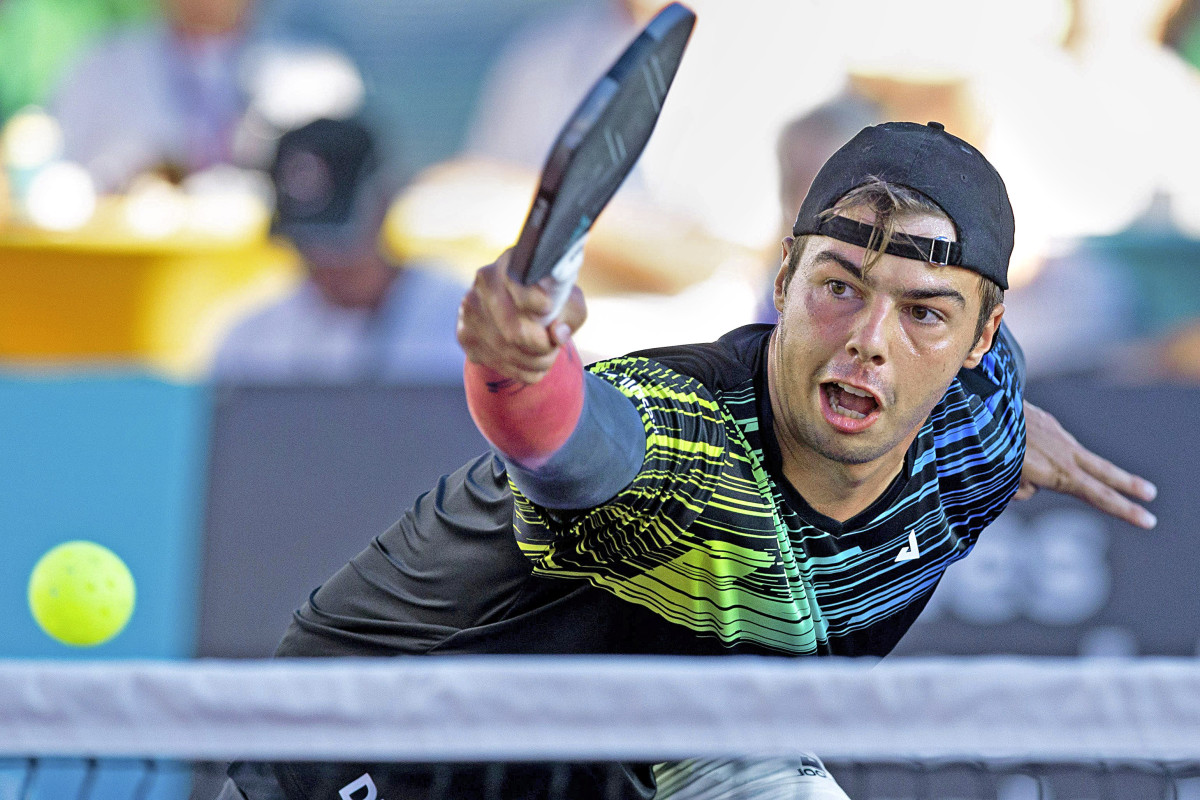
Last fall, Dundon invited Johns to meet him in Dallas. Two years earlier the billionaire had impetuously sunk $70 million into the Alliance of American Football, then almost as swiftly folded the startup before his losses hit nine figures. Now he, too, had been bitten by the bug, and he was curious to see whether Johns could become the “Tiger Woods of pickleball.” At their meeting, Johns and Dundon played a few matches without Dundon scoring a point.
Then, shortly before the New Year, Dundon hosted Johns at his casa in Cabo San Lucas. Again, Johns skunked him, 11–0. Dundon, who amassed his fortune in subprime auto loans, teamed up for a second match, this time adding a partner, Ernie Garcia, the founder of Carvana. Once again, nada.
“Finally, they made up jungle rules,” says an eyewitness. “Tom and Ernie could go into the kitchen, but Ben could not. They got a few points off him, but Ben still won.”
Dundon won too: He signed the world’s best pickleball player to one of those three-year exclusivity deals. Then he told the sport’s top players that Johns was in his stable and that they needed to sign their own contract offers by Jan. 1. Or risk missing out.
Douche-y move.
STANDING PAT
Pat Murphy, the ghost ship captain of the IFP and a retired retail management executive, arrived in Goodyear, Ariz., in 2009. Soon he discovered pickleball. Before long the club at his posh retirement community, PebbleCreek, boasted one of the largest pickleball memberships in the U.S., with more than 1,500 members.
Murphy got involved in USAP administration and in 2019 was named president of the IFP. To hear him and a few others tell it, the IFP had never been independent of USAP before then; it was managed by USAP board members. Which is why Murphy wanted to clean house. “When I was appointed,” says Murphy, “I told them, ‘I will do this job, but first I’m firing everybody.’”
And now everybody is firing him.
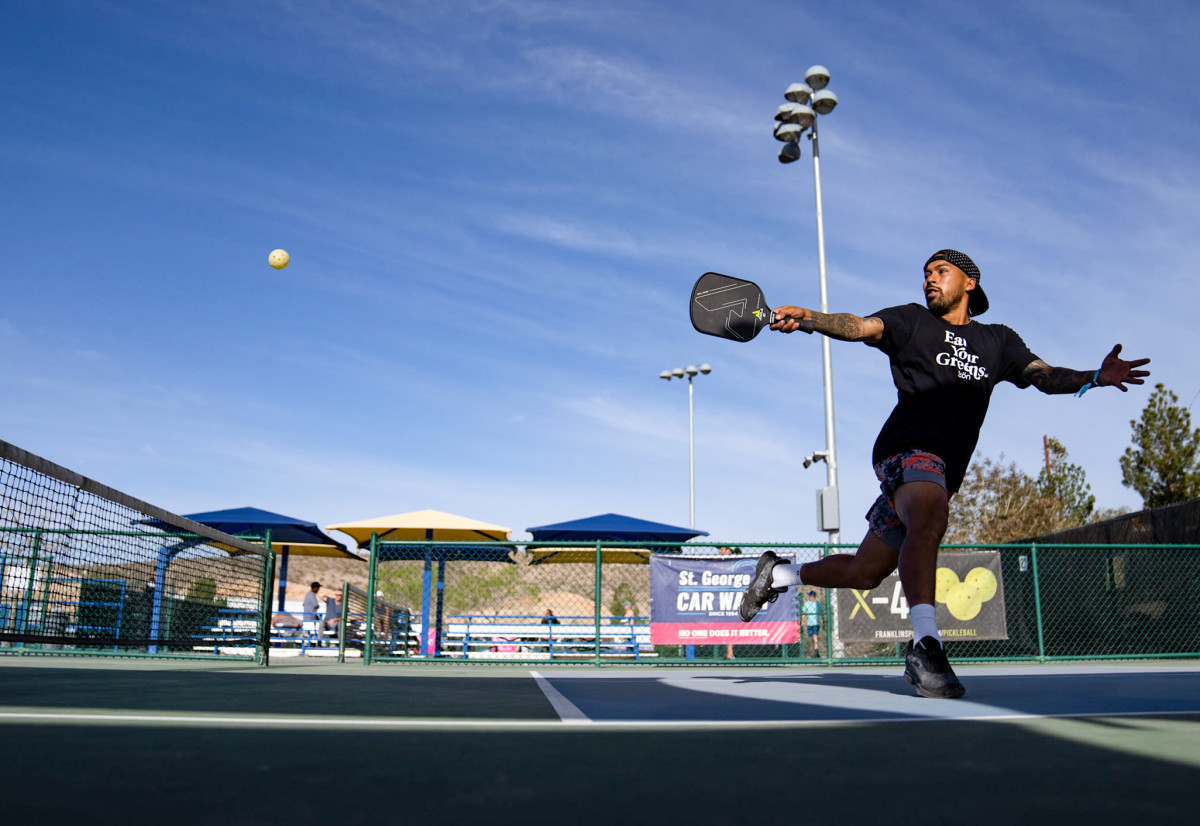
To be fair, Murphy, almost immediately upon taking office, was combating insurgents from within (USAP, which, again, constitutes more than 90% of the IFP’s membership) and without (that meddlesome Rifkind and his rival WPF). Identifying country membership totals as the simplest way to keep score against the WPF, Murphy installed Steve Sidwell as director of memberships and trotted out—no kidding—a No Country Left Behind policy. A contest between the two federations to accumulate 75 nations.
Dinkheads, the blog, ardently followed this arms race (“Nepal joins IFP!”), though it often sounded like competing Girl Scout troops announcing who had sold more Tagalongs—and often to the same grandma.
THE DREAMER
In 1991, Steve Kuhn graduated from his Ivy League school in the midst of an economic recession. He returned home to Minneapolis, lived in his parents’ basement and applied for a job delivering for Domino’s. “On the application there was a line that read Last School Attended, and I wrote Harvard,” Kuhn remembers. “The manager smiled and said, ‘Smart-ass.’”
Kuhn evokes Rain Man when he says “I was an excellent driver,” but also when he talks numbers. Between 2008 and ’14, Kuhn’s extraordinary understanding of finance and the upside-down housing market helped him take a relatively small hedge fund from $1 billion to $14 billion. He cashed out and began searching for windmills at which to tilt.
Clean water in Africa. A reasonable approach to immigration reform. “I met with 60 senators, 300 members of the House, and President Trump four times,” says Kuhn.
Then he moved to Austin, discovered pickleball and created a latter-day Xanadu. Kuhn refers to his 86-acre spread in Dripping Springs, Texas, as Dreamland. It holds a concert venue and a mini-golf course. And 16 pickleball courts.
Somewhere along the way, Kuhn teamed up with Seymour Rifkind and agreed to build Rif’s Pickleball Hall of Fame on the property. (Construction has yet to begin; right now it’s online-only.) And Dreamland is a pro pickleballer compound, too; Kuhn is luring premier players to come work as instructors by allowing them to live rent-free in anything from a modular home to a five-bedroom ranch. He has designs on a Bollettieri-style academy, because, yes, the age of the pickleball brat is just around the corner.
The dreamiest thing about Dreamland, though, is Major League Pickleball. Last November, Kuhn, using his plush venue and $150,000 in prize money as bait, assembled 32 of the world’s top players, from both tours—like Marvel and DC heroes in one film—for a three-day event. Athletes were divided into four coed teams and played singles, doubles and mixed doubles.
“I think it was the most important and best event in pro pickleball that ever happened,” says Kuhn.
Ever? You’ve got a jar of cocktail sauce in your fridge that’s older than pro pickleball. Still, the reviews were universally positive. “It’s going to be hard to go back to the other tours after this,” Johns said afterward.
About that. After it was announced in January that Dundon had purchased the PPA, Kuhn ventured north to Dallas to inquire about how that three-year exclusivity clause would be applied to his new mega event. “I was dreading that meeting,” says Kuhn, “but people told me Tom and I would get along fine.”
Within minutes, though, the tycoon tête-à-tête devolved into a scene from The Godfather. Dundon told Kuhn his stable of PPA talent would play in the MLP—as soon as Dundon owned the MLP. Kuhn bristled. I buy you out; you don’t buy me out! “That meeting lasted 20 minutes, but it might have lasted two,” recalls Kuhn. “I don’t know why I wasted those 18 minutes.”
Dundon’s camp sees it differently. “Steve wanted 10 events, and he did not want to pay for them,” says PPA spokesperson Hannah Johns (yes, Ben’s sister). “At that point, it’s almost a third tour. There has to be a good reason we do this besides out of the charity of our own hearts.”
This year, Kuhn will host another MLP event at his compound (and two more elsewhere). That competition will feature zero PPA players—even though Ben Johns lives in Austin … though, as you can understand, not at Dreamland.
TENNIS TRIED TO SQUASH PICKLEBALL!
Before Stu Upson vacated his role as the COO of the International Tennis Hall of Fame to become the CEO of USAP, he had some fun at the expense of his soon-to-be-former boss, two-time Grand Slam finalist Todd Martin.
“Todd just loves tennis,” says Upson. “He thinks pickleball is Satan.” Hence, in Upson’s final staff meeting, when only Martin knew he was about to depart, Upson jokingly suggested a redesign on the hallowed site in Newport, R.I. “Let’s pave over all these grass courts,” Upson said. “We can make 40 pickleball courts.”
The laughter was muted. Nervous at best. Is he serious? Whereas skiers have had to learn to share the slopes with snowboarders, tennis and pickleball are playing a zero-sum real-estate game. And tennis is not exactly holding serve. Remember: fastest growing sport in America.
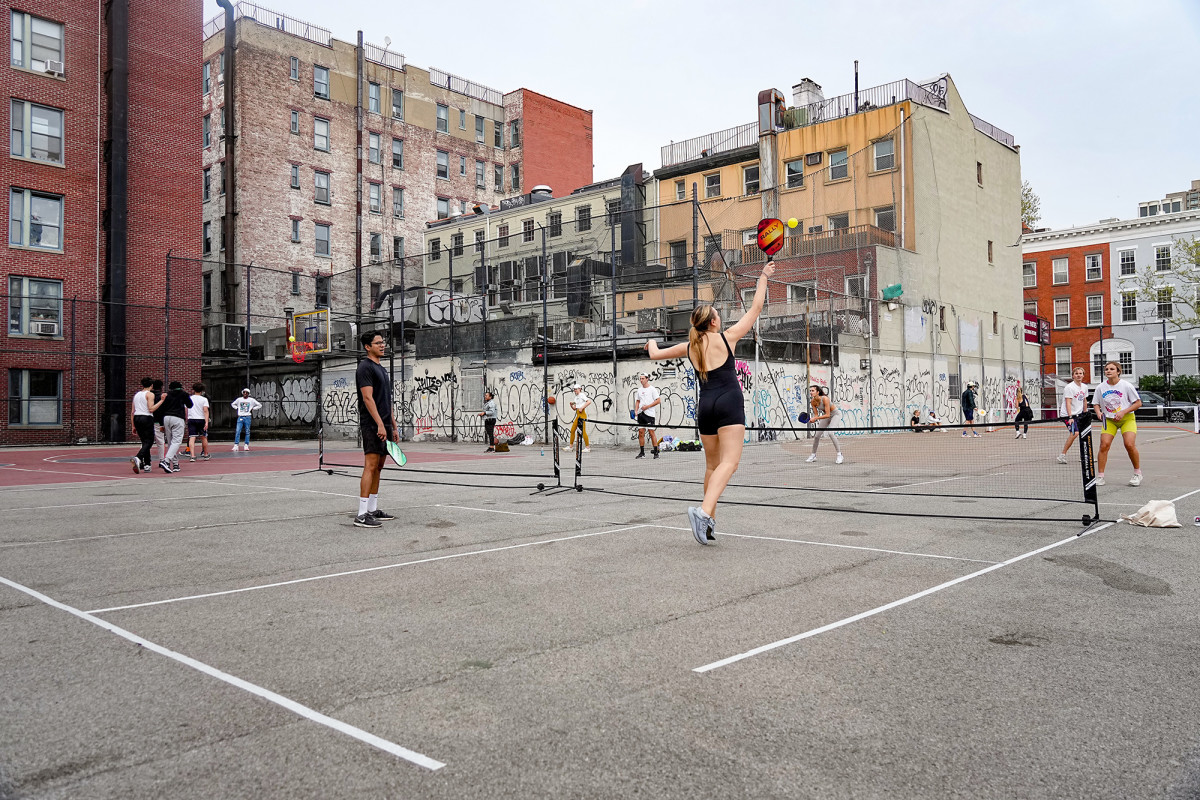
On a Sunday afternoon at the IronOaks Country Club in Sun Lakes, Ariz., pickleball’s ascension is on full display. Nine of the club’s 10 pickleball courts are in use, each with four players. Just one of its 10 tennis courts is inhabited, by two players.
“It’s simple real estate,” says Ben Johns, tapping his inner engineer. “You can fit four pickleball courts on one tennis court, and four pickleball players [each] versus two tennis players. That’s an 8-to-1 ratio in the same space.”
Johns was once a teen tennis player. Robert Elliott, whose Engage paddle is by far pickleball’s top seller—he developed it himself in his garage—played on the men’s tennis team at Villanova. Ken Herrmann played tennis in college, and long ago he was Seymour Rifkind’s son’s private tennis coach.
Tennis manufacturers and tennis clubs are practicing the first rule of survival: Adapt or die. Which is why Prince and Wilson now make pickleball equipment, and why clubs have reallocated space. At IronOaks, for example, annual pickleball memberships eclipsed tennis memberships; as a result, they removed two clay courts and added eight for pickleball.
At the time, IronOaks’ tennis stalwarts went door to door with a petition, hoping to stymie this incursion. They argued that the thwack of pickleball play was noise pollution. But this was Frank Sinatra trying to stop Elvis and the Beatles. “They told everyone it was about the sound the ball makes off the paddle,” says one IronOaks pickler. “Really, they just felt tennis being threatened.”
RELATIONSHIPS VS. RUTHLESSNESS
In April, at the Legacy Open in Mesa, Ken Herrmann could be seen toting trays of iced tea, which he distributed to thirsty players and patrons. Why does the CEO of the APP Tour do this? “Because I’m a good Italian Catholic boy,” says Herrmann. “That comes from my mom.”
It’s a good schtick, as it provides Herrmann an organic means to strike up conversations. But it’s also representative of the APP’s image. Hospitality. Herrmann’s six years at the USTA training facility in Florida provided him numerous opportunities to learn from Billie Jean King, who besides being an iconic figure in American sport had launched her own pro women’s tennis tour in the ’70s.
“You work every single day,” King told Herrmann. “Every single day you wear a different hat.”
Now, “if I watch Ken at tournaments, I’m exhausted,” says one player on the APP Tour. “You’ll see him setting up the nets, announcing matches, draping medals around players’ necks and writing out checks.”
Herrmann is a dinker. He refers to USAP respectfully as “the mothership.” Goes out of his way to accommodate the senior pro players and the amateurs. Thinks like a host. Should I serve sweet tea at the South Carolina Open?
Pardoe, in contrast, is a precocious sports entrepreneur. His tour is unapologetically geared toward the top pros. “I want a PPA event to feel like a PGA event or an ATP event,” he says. “When we first came in, there were four pros making enough to pay the bills. Now we have 30.” (Fifteen of each sex.)
Pardoe calls the PPA’s now-three-year exclusivity contracts “a protection on our investment.” As for the APP, he harbors no enmity. He foresees Herrmann’s league being a place where up-and-comers can cut their teeth. Triple A. “Pickleball is so big,” says Pardoe, “there’s a place for everybody.” (“That’s total bulls---,” says Ken Herrmann. “Four top players, including the women’s world No. 1, Simone Jardim, have gotten out of their PPA contracts in order to play on the APP Tour.”)
How many people conjure and then actualize their own pro sports tour before their 30th birthday? Pardoe has. But there are times, you will hear, when he behaves like a tyrant. “[The PPA] can be flat-out rude,” says Kim Jagd, a senior women’s pro who bounces between both tours. “And that’s not smart. [Pardoe] got pretty full of himself pretty fast. I still play his tournaments, though. I need the experience.”
In September 2020, another female player won $400 at a PPA event. Pardoe didn’t have her prize money check that weekend. She sent two emails to the PPA that went unanswered. Five weeks passed before the player, who wishes to remain anonymous, says she confronted Pardoe about her winnings. Finally, he wrote out the check. Waved it in her face. Then pulled it back for a moment.
“Here’s your check,” he said. “It’s your lucky day.” (A PPA spokesperson did not deny this exchange occurred.)
Herrmann, meanwhile, is bringing pickleball to Flushing Meadows on Memorial Day weekend for its big close-up. The APP will host the inaugural New York City Open on tennis’s largest stage in the U.S. (and has a contract to do so through 2024).
The biggest snag? Johns, a potential breakout star, will be AWOL. Because he’s PPA.
JOHNSON AND JOHNSON AND JOHNSON
David Letterman once joked in one of his trademark Top 10 lists that the NBA’s slogan ought to be Come See Our Johnsons. The APP should consider it.
At the Legacy Open, while Herrmann platters iced tea, JW Johnson takes refuge from the glaring sun in the pros tent. At 19, he’s the No. 1 men’s player on the APP Tour. His sister Jorja, only 15, is the No. 2 women’s player. And their mother, Julie, 50, is the No. 1 senior women’s player.
“I started playing pickleball to get away from you guys,” jokes Julie, who will play 30 tournaments a year with her brood while also serving as family travel coordinator. “King Richard had it easy.”
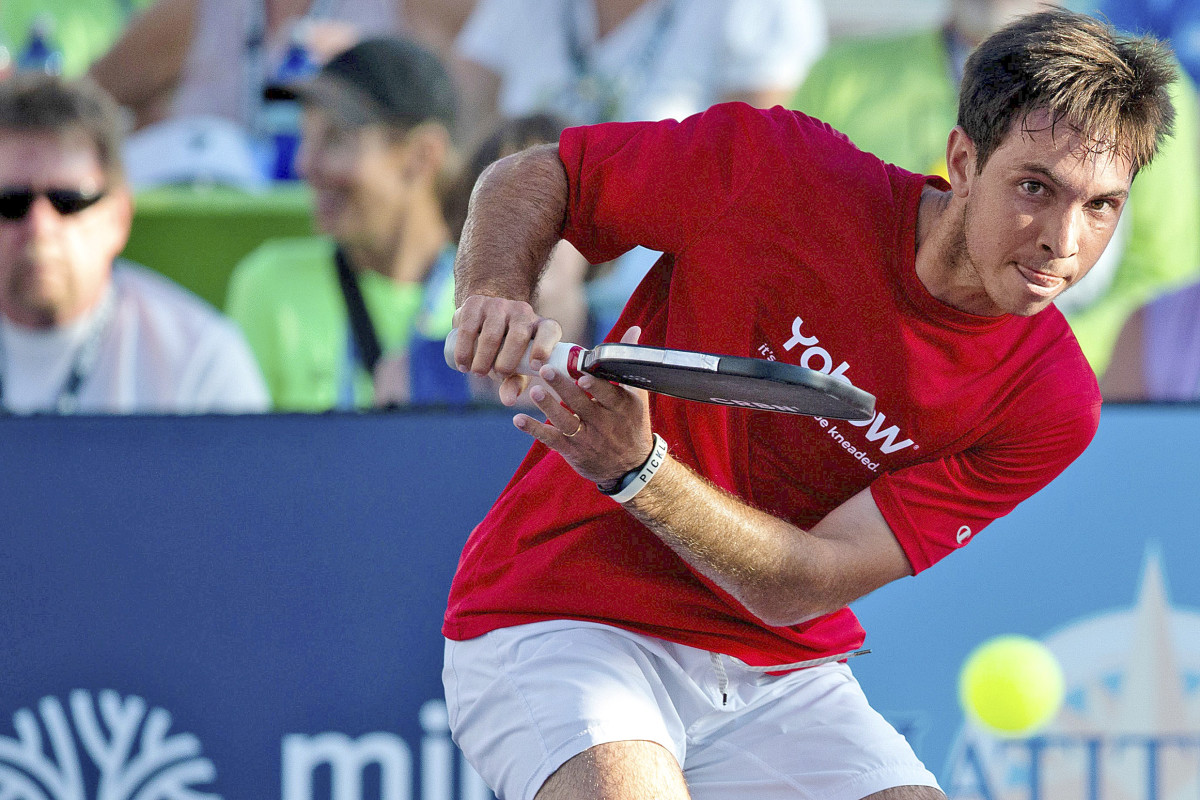
Whether you think the Johnsons are the first family of pickleball may depend on your tour allegiance. Anna Leigh Waters, also 15, is the top-ranked women’s player on the PPA Tour, and her mom, Leigh, is a top 5 doubles player. JW Johnson, though, is one of the more intriguing players on either tour.
Last August, only two months after shelving a nascent tennis career (see!) to focus exclusively on pickleball, JW entered his third event, the Tournament of Champions, in Utah, and beat Ben Johns, ending that epic streak.
“I said, ‘Good job, buddy,’” recalls JW’s mom. “And he said, ‘About time.’”
Two months. That’s the quantum of fortitude in pickleball, which is clearly in its Big Bang phase. “If you had told us about pickleball three years ago,” says Julie, “I would not have known what you were talking about.”
On Dec. 29, Pardoe texted JW and offered him one of the PPA’s exclusivity contracts. The guaranteed tournament appearance fee offered to the one player who had beaten the PPA’s marquee attraction? $1,000. And Pardoe needed an answer ASAP. Happy New Year!
“We hired an agent [with a background in pro tennis] who told us this is absolutely the worst sports contract he had seen in 30 years,” says Julie. But JW will be just fine. “The prize money and appearance fees aren’t what it’s about. The sponsorships are.”
Of the $60,000 JW has already earned in 2022, most came from endorsements. After he defeated Johns a second time, in February, Pardoe approached him again. “What will it take to get you to sign with us?”
Some days it all feels like a land grab.
Pardoe better hurry, though. He may already be too late. Steve Kuhn has offered the Johnsons a home in Austin if they relocate to Dreamland.
HATEFEST
The fiercest rivalry in pickleball is not Johns versus Johnson. Nor is it between the top-rated females, the teenagers Waters and Jorja Johnson. It’s not even Dundon and Kuhn.
The most piss-and-vinegar feud in all of pickleball is Pat Murphy against Seymour Rifkind. Why neither Herrmann nor Pardoe has yet organized a best-of-three grudge match is simply a failure of imagination.
To Murphy, Rifkind is an interloper. The Hall of Fame. The WPF. And to Rifkind, Murphy represents the old-boys network. It’s pickleball, yes, but it’s also tug-of-war (which, once upon a time, was an Olympic sport).
Rifkind cites an episode from 2017 involving a teacher certification program that he personally developed and shared with Murphy, who was then USAP’s director of training. Rifkind had hoped that USAP would pick up his nonprofit training program, but instead they partnered elsewhere. When Rif asked why, he says that USAP’s president at the time, Jack Thomas, told him simply, “Money.” And “from that moment on,” says Rifkind, “USAP was dead to me.” (Thomas says he does not recall the particulars of this exchange.)
“There’s no secret whatsoever about the way Pat and Seymour feel about each other,” says Steve Sidwell. “They both want to crucify each other … one perhaps more than the other.”
ENDGAME
Last fall, as Tom Dundon sized up Ben Johns (who’s now 4–2 against Johnson) as the potential jewel in his pickleball kingdom, and as Steve Kuhn staged his inaugural MLP event, and as the IFP and WPF chased after Laos or Togo or who-knows-where to onboard, the presidents of Pickleball Australia and Pickleball Canada came to the realization that having two international governing bodies was untenable. And something needed to be done. So they staged … not a coup, but an intervention. Jen Ramamurthy and Karen Rust sent a letter to both Murphy and Rifkind.
Ramamurthy, who lives in Brisbane, is keen on pickleball cleaning up its dual-governing bodies mess, pronto. “Australia cannot move forward,” she says, “unless there is one governing body of our sport.”
This first letter, in short, asked Murphy and Rifkind to either come together under a single organization or step aside. Rifkind replied, agreeing to meet halfway. From Murphy? Silence. Then, on a January conference call, Ramamurthy made a last-ditch proposal: that the IFP offer Rifkind a seat on its board, to unify the warring federations. Murphy adamantly refused, citing Rifkind’s “deceptive and unethical practices.”
And so followed a second letter, the Feb. 14 no-confidence note, the signees of which all agree on, foremost, these constitutional matters: that Murphy provided “no financial disclosure of IFP revenue and expenses,” that he never held an annual general meeting, and that the IFP was “not a democratic process.”
To sum it up: “He’s an autocratic leader,” says Sidwell, who was once quite close with Murphy. “Talk about an oligarch.”
Sidwell says he took part in a Zoom call in 2021 when Murphy outlined a process by which the board members could keep voting one another in, so as to limit turnover. “Isn’t there supposed to be a democratic process?” Sidwell recalls asking. “No,” Murphy replied, “because they’ll form a coup and take us over.”
“That,” Sidwell said after resigning in March, “was the straw that broke this camel’s back.”
Valavalkar, the commissioner from India who remains a Murphy loyalist, has shown contempt, too, for a representative board. Why? “Pickleball is like opium,” he wrote in April to a wavering IFP member country. “There is dire need to govern the sport with iron hands, but that does not mean being undemocratic.”
Not “undemocratic,” but then again, not democratic.
In response to all of this, Murphy (citing “outright lies … intended to deceive, disparage and bring harm to the IFP”) points out that “these same people asked me if I wanted to be president of the IFP; I was not elected.” He disputes the charge of a flawed election process. “We had open elections,” he says. (In addition to Sidwell’s Zoom call, another email, from Feb. 3, 2022, seemingly undermines the purity of those elections. There Murphy writes of a “stickier issue” and lays out how he hopes to manipulate IFP term limits and make them strategically overlap, to maintain the iron hands.)
As to the charge of never holding an annual general meeting, Murphy shares the minutes of the IFP’s Jan. 14 board meeting, in which he suggests holding one per continent (five total), but no specific date is named. And any such meeting would have been the first of his term.
On the matter of Murphy’s alleged recalcitrance when it comes to financial disclosure—“they don’t tell us where the money is going,” as Friedenberg says; “they are not transparent!”—Murphy pushes back. During the IFP’s Jan. 14 board meeting, Sidwell (not on the board, but Murphy’s predecessor as prez) requested a copy of the IFP financial report. That request was met … but Murphy suggested sharing “on a need-to-know basis,” and treasurer David Jordan proposed doing so “only upon request.”

And then there’s this: Murphy has committed $25,000 of IFP money to the construction of a mega sports complex in Toquerville, Utah, that is planned to include 60 pickleball courts in addition to—Murphy’s latest return banger to Rifkind—an International Pickleball Hall of Fame. “This is something a national governing body would do, not an international sports federation,” says Sidwell. “And this decision was made without the approval of IFP member countries.”
In fact, that $25K is absent from the IFP’s itemized expenses from 2021, as is any mention of the Toquerville expenditure. Total expenses are listed as $86,519, whereas the itemized subtotal sum is $62,154—a discrepancy of $24,365. “The difference,” says Jordan, the IFP treasurer, “is the $25,000 we put in escrow for the Toquerville project.” Why wasn’t it listed in the expenses? “I just forgot to add it in,” Jordan says. So, it’s essentially a real estate investment? “Yes. Those former [IFP] members have their feet stuck in the mud.”
If built, that complex would bring the pickleball hall of fame total to three … except that late last year USAP halted its project. So, now we’re back to two pickleball halls of fame.
Meanwhile, the international movement languishes as the few prominent member countries vacillate on whether to register with the WPF, wait for Murphy to accept defeat (among former colleagues, the joke goes: “Who’s going to blink first, Pat or Putin?”), or burn it all down and start anew. “We had two [federations],” says Rust, from Pickleball Canada. “We want one. And we may end up with three.”
Finally, there’s this: Tom Dundon does not actually own the Pro Pickleball Association. Not yet. A few blogs reported on Jan. 2 that Pardoe and his family had sold a majority stake to Dundon’s private equity company. And neither Dundon nor the PPA ever disputed that. But “there’s still some paperwork left to do,” says Hannah Johns. “We should be announcing that in a couple of days.”
That was on April 29, and it’s still not official. If Dundon were to back out, it would mark the second professional sports league he left financially high and dry in the past four years. “I wonder,” says Julie Johnson, “if Tom just gets bored.”
A RABBI, A MUSLIM AND TWO CHRISTIANS WALK ONTO A PICKLEBALL COURT
They meet on Mondays at 8 a.m.: 13 people, men and women, secular and religious. Jews, Christians, Muslims. They gather at the Haifa branch of the Israel Tennis and Education Center, a half mile from the Mediterranean Sea. They come to play pickleball.
“We have a regulation court,” says Rabbi Golan Ben-Chorin, the leader of this tribe. “We use the net that was brought over by Seymour when he first introduced pickleball to Israel.”
In 2017, Rifkind, the son of a Holocaust survivor, flew to the Holy Land with 100 paddles, 25 balls and four nets. “You’ve got Middle East politics and thousands of years of hatred to overcome,” he says. “But almost anyone can play pickleball. Suddenly you’re laughing, teasing each other over bad shots. And you start thinking: This guy across the net’s not such a bad guy.”
And now, in a not-so-little town near Bethlehem, a man of faith and 12 followers are spreading the liturgy of a sport with global ambitions. “I decided to combine two passions,” says the rabbi. “The old—interfaith engagement—with the new, pickleball. I call it the ‘cross-cultural pickleball initiative.’”
Serving the Lord while serving underhanded. Peace on Earth, and stay out of the kitchen.
Editors’ note, May. 31 at 10:45 p.m. ET: An earlier version of this story referred to Rifkind’s training program as for-profit and mischaracterized, slightly, the rules of the kitchen.
Read more of SI’s Daily Cover stories:
• A Physical Therapist to the Stars, Esther Lee Is Now Facing Down Death
• Does the NBA Have a $@&!*% Problem?
• Sicilian Scrum: One Italian Rugby Club Is Standing Up to the Mafia
